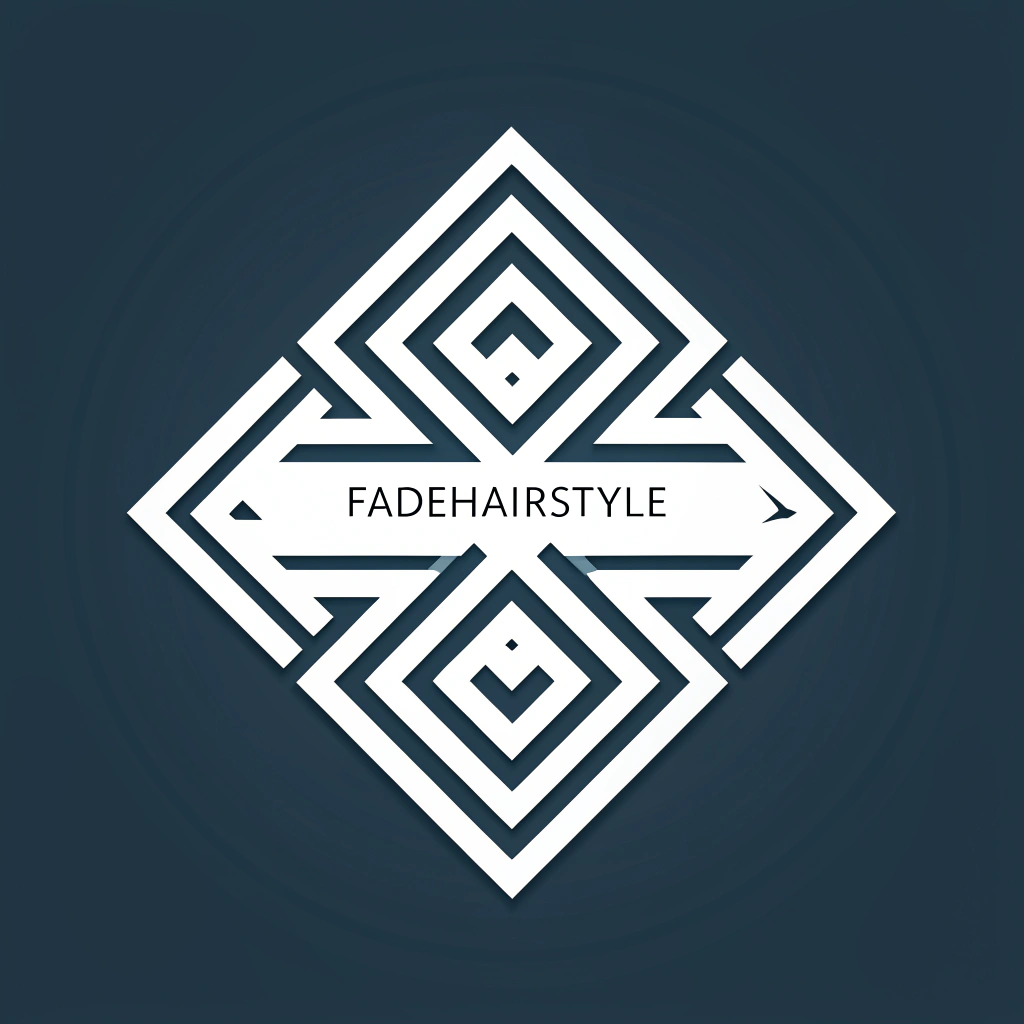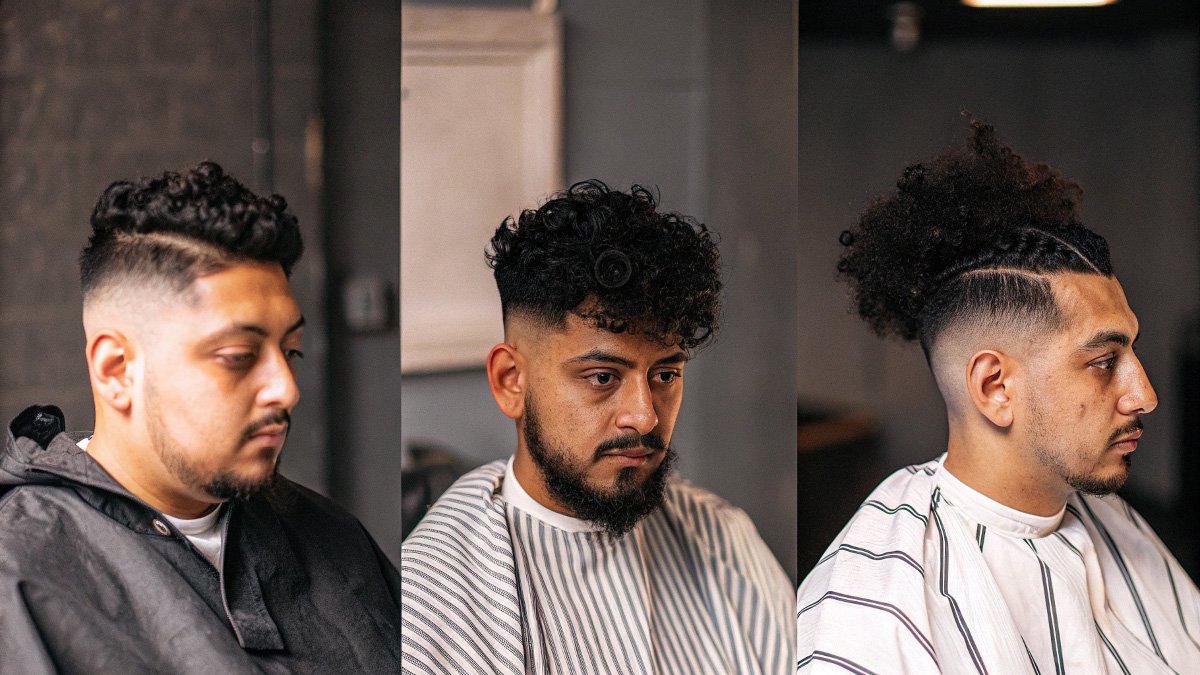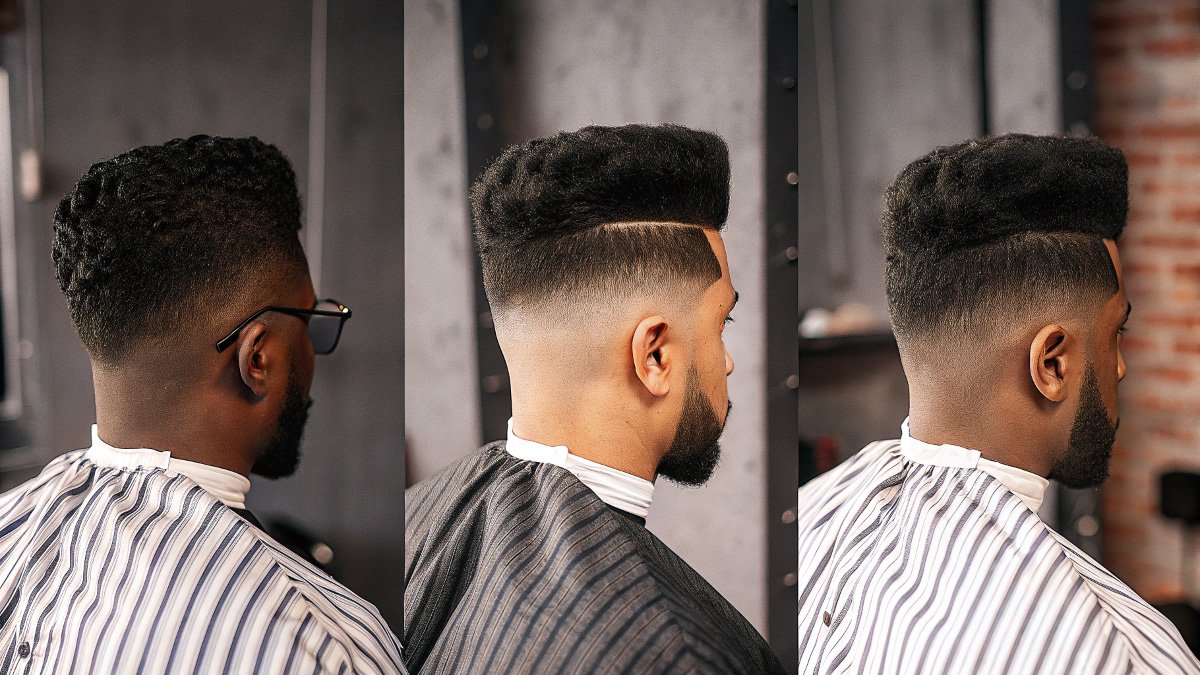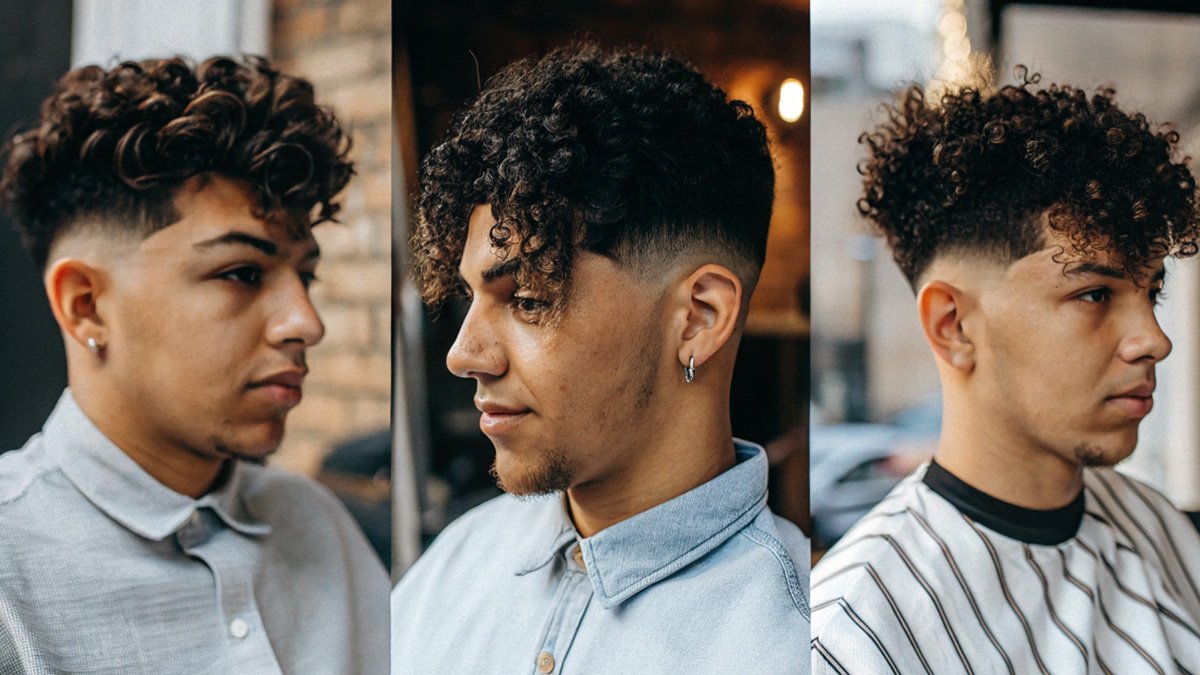Bald fade haircuts dominate modern barbershops for one simple reason: they work. This cutting technique creates clean lines, sharp transitions, and versatile styling options that suit every man’s needs. Professional barbers use precise clipper work to blend hair from skin level up to longer lengths on top.
The technique requires skill, but understanding the basics helps you communicate better with your barber. You get exactly what you want when you know how different fade heights, positions, and styling options work together. This knowledge transforms your next barbershop visit from guesswork into a targeted plan.
Men choose bald fades because they offer maximum impact with minimal daily effort. The clean sides require little styling while the longer top section provides endless possibilities. Whether you prefer sleek professional looks or textured casual styles, this cutting method adapts to your preferences.
Understanding Bald Fade Fundamentals
The core principle behind every bald fade involves gradually transitioning hair from completely shaved skin to longer lengths. Barbers start at the lowest point with a razor or zero-guard clipper, creating a completely smooth surface. They then use progressively longer clipper guards as they move upward.
This gradual blending eliminates harsh lines between different hair lengths. The smooth transition creates visual flow from the shortest areas to the longest sections. Professional execution requires multiple passes with different tools to achieve seamless results.
The skin-level starting point distinguishes bald fades from other tapering techniques. Regular tapers leave short hair at the bottom rather than going completely bare. This difference creates a sharper contrast and cleaner visual impact in bald fade variations.
Precision becomes critical because mistakes show immediately on bare skin. Barbers must maintain steady hand movements and consistent pressure throughout the cutting process. The exposed scalp reveals any uneven blending or missed spots that would hide under longer hair in other styles.
Classic Fade Height Classifications
Height placement determines how dramatic your fade appears and where the transition begins. Each position creates different visual effects and suits various face shapes, hair types, and personal preferences.
High Skin Fade Variations
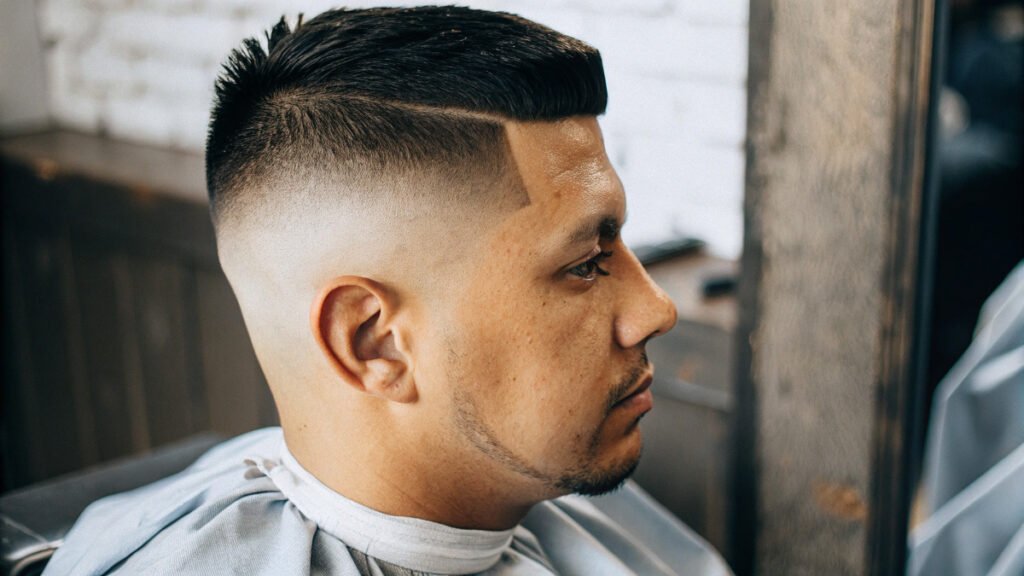
High Skin Fade to Texture creates maximum contrast between shaved sides and textured top sections. This style works well for men who want dramatic visual impact while maintaining natural hair movement on top. The high positioning draws attention upward and can make faces appear longer.
High Bald Fade with Carved Part adds precise line work to the dramatic height difference. The carved part creates additional definition while the high fade provides clean contrast. This combination works particularly well for professional settings that allow modern styling approaches.
Gentleman’s Cut with High Skin Fade combines traditional barbering with contemporary edge work. The square-cut top maintains classic proportions while the high fade adds modern appeal. This style suits round faces because it creates vertical emphasis.
Mid-Level Positioning Options
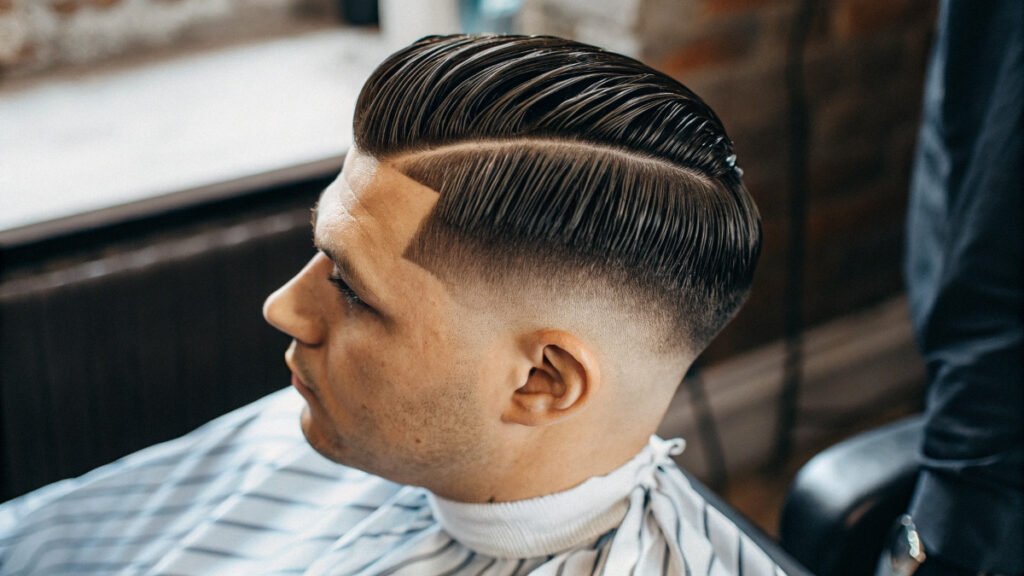
Mid-Skin Drop Fade with Hard Part creates balanced proportions with added definition. The drop curve follows natural head contours while the hard part adds precision. This combination works well for both casual and professional environments.
Mid-Skin Fade with Side Part offers versatility for various styling approaches. The moderate height provides clean lines without appearing too extreme. The side part adds classic styling elements that work with multiple hair textures.
Bleached Mid-Skin Fade combines color techniques with precise cutting. The mid-level positioning provides adequate canvas for color work while maintaining professional appearance. This style allows creative expression within structured framework.
Low Fade Subtlety
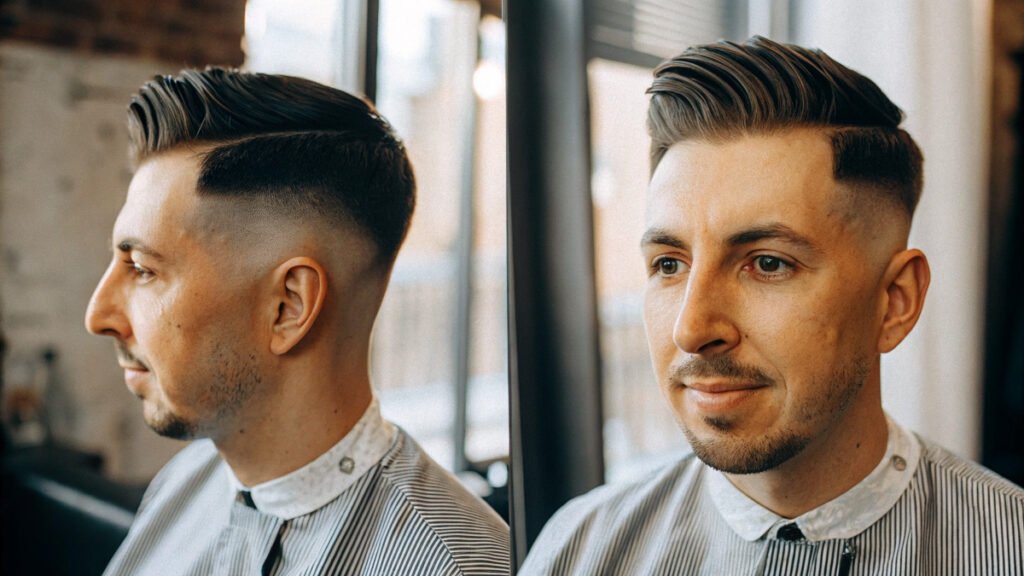
Low Skin Fade begins just above the ear and continues around the neckline. This subtle approach maintains professional appearance while adding modern edge. The minimal shaved area creates clean lines without drawing excessive attention.
Low Skin Fade for Pronounced Back of Head addresses specific head shapes that need visual balance. The low positioning minimizes prominent occipital bones while creating clean transitions. This technique works particularly well for men with longer necks.
Barely There Fade creates the most subtle transition possible while still achieving the bald fade effect. This option suits conservative workplaces and men new to fade styles. The minimal contrast grows out naturally without obvious demarcation lines.
Specialized Pattern Techniques
Beyond basic height placement, several specialized techniques create unique visual effects and personalized styling options. These variations require skilled barbers but offer distinctive results.
Curved and Drop Variations
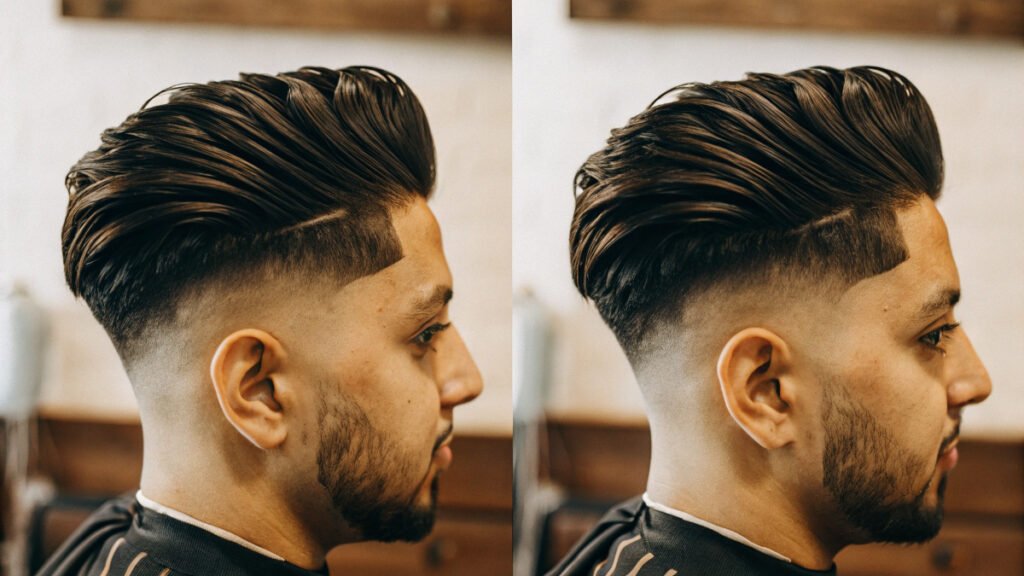
Drop Skin Fade follows the natural curve behind your ear rather than maintaining straight horizontal lines. This technique creates organic flow that complements head shape. The curved transition appears more custom-fitted than standard straight-line approaches.
Smooth Drop Fade emphasizes seamless blending within the curved pattern. This variation focuses on perfect transition work while maintaining the drop shape. The smooth execution prevents harsh lines or uneven blending.
Contemporary Drop Fade to Skin updates the classic drop technique with modern precision. This style works well with various top lengths and textures. The contemporary approach emphasizes clean execution and sharp definition.
Wedged Drop Fade adds angular elements to the curved drop pattern. The wedge shapes create additional visual interest while maintaining the drop fade’s natural flow. This combination suits men who want unique styling without excessive complexity.
Burst and Radiating Patterns
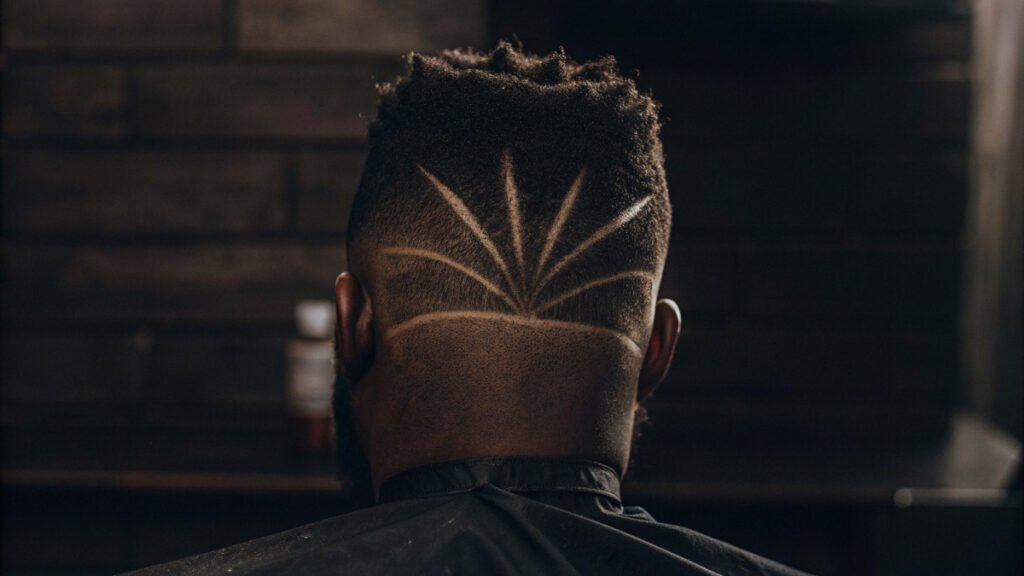
Burst Fade radiates outward from behind the ear in a semicircular pattern. This technique creates fan-like effects that add movement to the sides of your head. The radiating lines complement textured top styles particularly well.
The specialized cutting technique requires experienced barbers familiar with radiating pattern requirements. The burst effect works well with longer top styles because it creates complementary movement below. This variation adds visual interest while maintaining professional appearance.
Taper Combinations
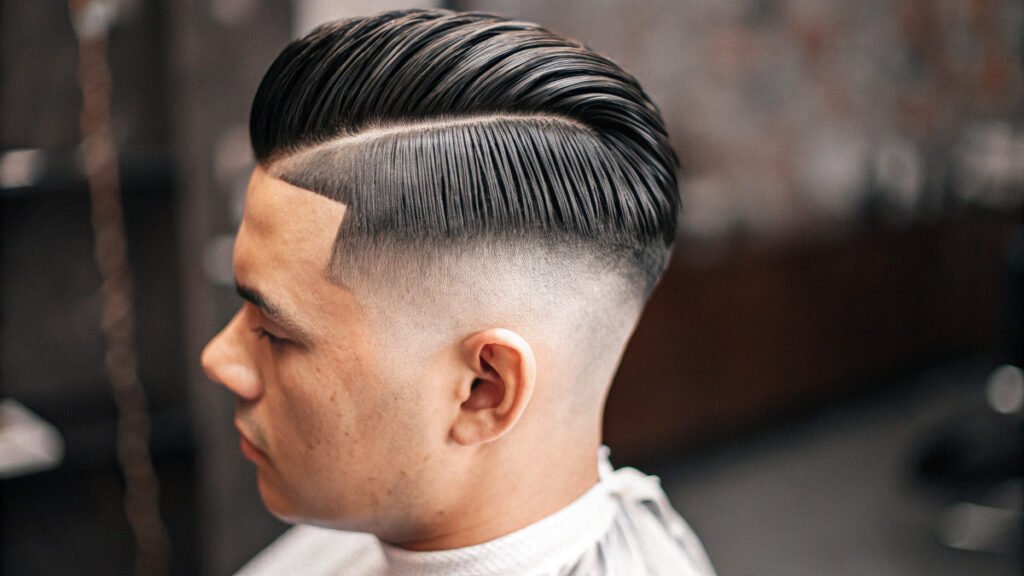
High Taper provides fade benefits in smaller sections rather than covering the entire head. This approach works well for men who want clean definition without full fade commitment. The technique maintains more hair while adding modern edge.
High Taper with Braids demonstrates how taper techniques work with protective styling. The clean edges complement braided patterns while maintaining the hair’s natural texture. This combination suits men who want both traditional and contemporary elements.
Combover Taper Fade combines classic combover styling with modern fade techniques. The longer top section provides styling versatility while the faded sides add contemporary appeal. This style works well for business professionals who want subtle modern touches.
Top Style Integration Options
The hair you maintain on top significantly impacts your fade’s overall appearance. Different top styles create various effects when combined with bald fade techniques.
Textured and Natural Approaches
Textured Skin Fade emphasizes natural hair movement on top while maintaining clean sides. This style works well for men with wavy or curly hair who want to showcase their natural texture. The contrast between textured top and smooth sides creates visual interest.
Top Curls and Smooth Sides maximizes the contrast between natural curl patterns and clean fade work. This combination celebrates natural hair texture while maintaining modern edge. The style requires minimal daily styling while providing maximum impact.
Crop With Long Fringe and Natural Texture creates forward-moving hair movement that balances the fade’s backward transition. The longer fringe provides styling versatility while the natural texture adds visual interest. This style suits men with dense hair that can support longer top sections.
Curly Fade works with natural curl patterns to create effortless styling. The fade provides clean contrast while the curls add natural movement and texture. This approach requires minimal daily maintenance while delivering consistent results.
Sleek and Structured Styles
Swept Top with Skin Fade creates smooth lines that flow from the longer top section to the clean sides. This style works well for professional settings that require polished appearance. The swept movement adds sophistication while maintaining modern appeal.
Skin Fade with Natural Part incorporates the hair’s natural growth patterns into the overall design. This approach creates authentic styling that works with rather than against natural hair direction. The natural part adds definition without appearing forced.
Faded Undercut combines undercut techniques with fade blending for maximum contrast. This style creates dramatic difference between top and side lengths. The technique works well for men who want bold styling with clean execution.
Classic Revival Options
Pompadour Fade updates traditional pompadour styling with contemporary fade techniques. The voluminous top section creates vintage appeal while the faded sides add modern edge. This combination works well for special occasions and professional settings.
Soft Pompadour Fade provides a gentler version of the classic pompadour with subtle fade work. This approach maintains the style’s elegance while reducing dramatic contrast. The soft execution suits daily wear and various professional environments.
Fade to Flat Top revives 1950s styling with modern precision. This vintage-inspired cut works best with hair that has natural volume and texture. The flat top requires regular maintenance but provides distinctive styling that stands out.
Creative and Bold Expressions
French Crop High Skin Fade combines European cutting techniques with American fade precision. The crop’s forward movement contrasts with the fade’s clean lines. This style works well for men who want international styling influences.
Mohawk Fade creates dramatic center focus while maintaining professional side cleanliness. The fade technique softens the mohawk’s traditional boldness while preserving its distinctive shape. This combination allows creative expression within acceptable parameters.
Gentleman’s Buzz with Fade updates military-inspired cutting with precise fade work. The buzz cut’s simplicity contrasts with the fade’s technical execution. This style provides maximum convenience while maintaining sharp appearance.
Specialized Detail Work
Advanced barbers can add custom elements that personalize your fade and create unique styling signatures.
Precision Line Work
Bald Fade with Ice Pick Sideburns creates narrow, pointed sideburn shapes that add definition around the ear area. These precise lines require skilled execution but provide distinctive styling elements. The ice pick shape complements the fade’s clean lines while adding personal flair.
The technique involves tapering sideburns to extremely narrow points that create sharp definition. This detail work requires regular maintenance to preserve the precise shape. The style works particularly well with beard combinations that emphasize facial structure.
Pattern Integration
Design elements can be incorporated into the faded areas to create custom artwork. Simple geometric patterns, lines, or more complex designs use the shaved area as canvas. These additions make your fade unique while maintaining the style’s fundamental structure.
Start with simple line work before attempting complex patterns. Basic designs require less maintenance and provide opportunity to assess your comfort level with decorative elements. More elaborate patterns need frequent touch-ups to maintain their intended appearance.
Face Shape Optimization Strategies
Your facial structure determines which fade variations create the most flattering results. Understanding how different heights and styles interact with natural features helps you make informed decisions.
Round Face Enhancement
Round faces benefit from height-adding techniques that create vertical emphasis. High bald fades draw attention upward and make faces appear longer. The sharp contrast between shaved sides and longer tops enhances this lengthening effect.
Textured tops work particularly well because they add height and visual interest. Avoid flat, slicked-down styles that reduce overall height and emphasize facial width. Volume and texture create better proportional balance for round facial structures.
Square Jaw Complementing
Square faces possess strong angular features that work well with various fade heights. Mid-level fades often provide ideal proportional balance without overwhelming natural bone structure. Low fades maintain temple width that complements square jaw structures naturally.
Avoid extremely high fades that might create excessive contrast with strong jaw features. The dramatic height difference can make square faces appear unbalanced. Choose moderate heights that enhance rather than compete with natural features.
Oval Versatility
Oval faces work well with virtually any fade height because of naturally balanced proportions. This versatility allows choice based on personal preference, lifestyle requirements, and styling goals rather than facial correction needs.
Experiment with different heights to find preferred looks and maintenance schedules. Hair texture and density may influence optimal fade positioning more than facial structure with oval faces.
Professional Execution Standards
Quality bald fades require skilled execution using proper tools and techniques. Understanding professional standards helps you evaluate barbers and set appropriate expectations.
Communication Essentials
Clear communication prevents misunderstandings and ensures satisfactory results. Bring reference photos showing exact fade height, top style, and overall appearance you want. Visual references eliminate ambiguity better than verbal descriptions alone.
Discuss styling routines and maintenance preferences before cutting begins. This information helps barbers suggest appropriate lengths and techniques that match daily habits. Be honest about time spent on hair styling each morning.
Quality Indicators
Smooth transitions between different hair lengths indicate skilled execution. You should not see visible lines or steps between sections when examining your fade from any angle. Professional work creates seamless flow from skin level to longer lengths.
Even blending around the entire head demonstrates consistent technique application. The fade should maintain the same gradient rate whether viewed from front, side, or back positions. Clean edge work around hairlines shows attention to detail.
Maintenance and Care Requirements
Consistent upkeep keeps bald fades looking sharp and professional. Understanding maintenance timing helps you plan appointments and budget appropriately.
Touch-Up Scheduling
Most bald fades require professional attention every two to three weeks to maintain crisp lines. The skin-level areas show regrowth quickly, especially with dark hair colors. High fades need more frequent attention because large shaved areas make regrowth visible sooner.
Special events may require additional touch-ups to ensure optimal appearance. Schedule appointments two to three days before important occasions to allow minor skin irritation to resolve.
Home Care Strategies
Daily washing keeps scalp healthy where hair is shortest. Use gentle shampoos that clean without over-drying exposed skin areas. Moisturizing becomes important for exposed scalp areas, especially during winter months.
Sun protection prevents burning on exposed scalp during outdoor activities. Use sunscreen or wear hats when spending extended time outside. Apply styling products to longer top sections rather than faded sides.
Troubleshooting Common Issues
Understanding potential problems and solutions helps you address concerns quickly and maintain optimal fade appearance between professional appointments.
Growth Pattern Management
Some head areas grow faster than others, causing uneven fade appearance over time. The neckline and areas behind ears often show regrowth first. If you notice significant unevenness before scheduled appointments, contact your barber for quick touch-ups.
Skin Sensitivity Solutions
Fresh fades may cause minor skin irritation, especially for men with sensitive skin. This typically resolves within a day or two as skin adjusts. Use gentle, fragrance-free moisturizers if irritation persists beyond the initial day.
Conclusion
Bald fades offer versatile styling options that suit various face shapes, hair types, and lifestyle requirements. From subtle low fades to dramatic high contrasts, from classic pompadours to contemporary textured styles, the range of possibilities ensures every man can find his ideal look.
The key to success lies in choosing appropriate fade height and positioning based on individual features and preferences. Whether you select a burst fade for creative flair, a drop fade for natural flow, or a straight fade for clean precision, professional execution ensures optimal results.
Regular maintenance schedules keep fades looking sharp and professional. Quality products and proper application techniques help maintain styling between barber visits. Communication with skilled barbers improves results significantly and leads to consistently excellent cuts that meet specific needs and preferences.
